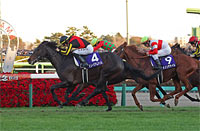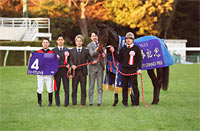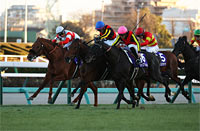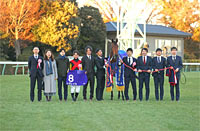Arima Kinen (The Grand Prix) (G1) - Comments from runners' connections

Bless Journey
Bless Journey (colt, 3)
Shozo Sasaki, trainer
“He took on the Kikuka Sho (Japanese St. Leger) just 40 days after switching stables and we actually had only about two full weeks to get him ready. In addition to having a very long time off before that, it was his first time at the distance and the conditions were tough. I think his last start was more representative of the kind of race he’s capable of. In order to help him recover from his last race in a week, we used the swimming pool. After that, we galloped him lightly. This week, the jockey rode fast work with a focus on the finish. And this should have him ready. He has a very nice turn of foot so in the beginning I thought his best distance would be in the 1,600-2,000 meter range, but he settles very well. So, I thought he could be flexible with the distance. The competition is taking a huge leap upward, but he has won two graded races and I think he has a lot of talent. His career is still young and he has lots of room to improve. I’m looking forward to it.”
|
|

Cheval Grand
Cheval Grand (horse, 5)
Yasuo Tomomichi, trainer
“Unlike last year, this year he had an ideal rotation going in to the Japan Cup. I had my hopes up because he was in very good condition. He made use of the inside draw for a ground-saving run and he had put on muscle on his hindquarters, so when he pulled away he was fast. It wasn’t a stressful run so he recovered from it quickly. He stayed at the training center and it was our plan all along to come here. Last week, just like before last race, he worked in a trio and I gave instructions to push him even once past the finish line. He had a brisk workout this week too. He’s working a lot better now in the mornings than he used to. If he breaks well, he’s now able to keep up with the pace from the very start. I have no worries about the change in course. Hugh Bowman will be riding him again. I am looking forward to it because he’s ready.”
|
|

Curren Mirotic
Curren Mirotic (gelding, 9)
Osamu Hirata, trainer
“In the Copa Republica Argentina, with the long Tokyo stretch, I’d say he held his ground very well. It was in no way a poor race. I gave him a bit of time off and he’s been trained with this race as the goal. Last week he was slow working in tandem but he’s never been good in morning work, so that was normal for him. It’s his third start since returning from the layoff, but I don’t think we’ll see any huge improvement. He’s full of energy though and he doesn’t show his age. With his style of running, I think the more compact Nakayama course over 2,500 meters will suit him. He wasn’t bad here four years ago either. I’d like him to get a good position and make his move early. If he can run his own race, I think he’ll put up a fine fight.”
|
|

Kitasan Black
Hisashi Shimizu, trainer
“Results are results. His Japan Cup results are what they are. The field was very strong. He came out of the race without any injury, so I was able to put him back into training right away. Last week, my instructions were to give him a hard workout and I’ve never before seen jockey Yu Kuroiwa move those reins as hard as he did. He eased up right before the finish as he usually does but another push and he responded immediately. His overall time was good and his time over the last lap was 12.2 seconds. It was a solid workout and I’ll have no regrets with this. Things have gone according to plan. My only wish is that he stays strong and healthy. This is his last run and I’m trying not to think too much about it but I’m getting pretty excited. He is the fans’ overwhelming favorite and he hasn’t won the Arima Kinen yet. I’m hoping he can meet their expectations this time. His results last race were frustrating and I’m hoping that somehow he can get good results this time.”
|
|

Mikki Queen
Mikki Queen (mare, 5)
Yasutoshi Ikee, trainer
“She was in better shape for the Queen Elizabeth II Cup this year than she was for it last year and so I had had my hopes up. After passing the finish line she pulled ahead of the others and she needed just about those 20 meters more. She’s talented and I think she ran her best race. Her condition was more stabilized before that race, unlike last year, and after the race things have gone smoothly without any big changes. In her fast work, I’ve given instructions to have her pass the other horse and I think her movement has been good as usual. She has some trouble getting her engine revved over the Kyoto outer course and the tighter-turned tracks don’t suit her, so I think she’s unsuited to Nakayama. Still, last year she did her best, but she’s not at the point where she can go up against the best male horses and beat them, so key is going to be how soon she can make her move.”
|
|

Queens Ring
Queens Ring (mare, 5)
Keiji Yoshimura, trainer
“Last out in the Queen Elizabeth II Cup, the pace was slow and it all came down to late speed. I think the difference came down to the position she’d traveled in. She did run her own race and it was a smooth one. She gained ground nicely in the finish. If things had unfolded more to her liking, I think she would have done better. We kept her at the training center after that and she has gotten regular work. She’s only been raced twice this autumn and she’ll be going in to the race fresh. Compared to last year, she has filled out more and, most importantly, I no longer have to worry about her not eating. She’s agile and I think the shape of the Nakayama 2,500-meter course will suit her. She’ll be a broodmare soon, so the most important thing is that she comes out of the race in good shape. I’m hoping she’ll run a good race.”
|
|

Rainbow Line
Rainbow Line (colt, 4)
Keiichi Asami, assistant trainer
“The going was really bad in the Tenno Sho (Autumn) and in the Japan Cup he battled to the end. These last two races he’s been a lot calmer in the van and the pre-parade ring than he was in the spring. He came back to the training center on Dec. 12, two weeks before the race as he usually does. He was refreshed and looking good. And with work on Dec. 17 and Dec. 20, things should be in order. In the spring over the Nakayama 2,500 in the Nikkei Sho, he finished well enough despite a less-than smooth trip. Because he had a nice, long rest over the summer, I’ve given him three starts. It looks like he’ll be going in to the race in as good shape as he was before. He’s had good races this autumn and I’m hoping he’ll take the bit nicely traveling about midfield, read the pace well and make his move.”
|
|

Rouge Buck
Rouge Buck (mare, 5)
Masahiro Otake, trainer
“Things went well after she won the All Comers and she went in to the Queen Elizabeth II Cup in good shape, but in the gate she kicked the back of the gate and was slow out and ended up racing from behind. And with the slow pace, she did what she could. We sent her to the farm for time off and because she was in good shape, we decided to race her here. She returned to the training center on Dec. 9 and worked lightly up the hill course on Dec. 13. No matter how much she moves, she’s always rather stiff, but she’s full of energy. We gave her a fast workout on the weekend and on Dec. 20. This is her first Arima Kinen since she was 3 years old and she’s calmer now and has more strength, so I’m expecting her to get better results this time. Considering the shape of the course, I was hoping for an inside draw.”
|
|

Sakura Empereur
Sakura Empereur (horse, 6)
Takashi Kanari, trainer
“In the Tenno Sho (Autumn), he was racing over the sloppy going just like everyone else, so I won’t say that was the reason he did poorly. He was in very good shape. Taking the ground into consideration, the jockey sent him to the front but I don’t think the results would have been much different even if he’d raced from further back. He’s not the toughest of horses and he was tired after that race. He’s not tough enough to have been at his best in the Japan Cup, so I gave him a more relaxed rotation and set this race as the goal. Things have gone as planned. He hasn’t shown any big changes physically but he is more on his game with each workout. Some say the distance is too long for him but we won’t know until we try it.”
|
|

Satono Chronicle
Satono Chronicle (colt, 3)
Yasutoshi Ikee, trainer
“Last out in the Challenge Cup, it was close in the end and I was really on edge watching, but he must have had more left than it looked like he did. I think the jockey did an excellent job. But I think he’s also not a very difficult horse to handle. The going was bad in the Kikuka Sho (Japanese St. Leger) but with a fast track the results are different, after all. There was no major change after that race, so I decided to aim him here even though there were only two full weeks in between. We breezed him on Dec. 17 and Dec. 20. After his last race, the jockey said that he thought 2,000 meters was too short for him and that 2,500 meters would probably suit him. He has done well at Nakayama before and the tighter turns shouldn’t be a problem. He’s only 3 years old so he’ll be carrying 55kg too. So, with an eye to the future, I’m eager to see how he’ll do up against top-class older horses.
|
|

Satono Crown
Satono Crown (horse, 5)
Kazutomo Mori, assistant trainer
“In the Tenno Sho (Autumn), he had an inside draw and was able to travel in a good position, but last time out he drew wide and his start wasn’t that fast. He traveled from a rearward position and he used up a lot going around the third and fourth turns and lost speed. To be sure, the draw and the trip were not in his favor, but it was also a mental problem and it made me realize once again just how difficult he is. It took a while to decide whether we come here or not. After the race we followed our usual routine but he seems to be too used to that and so I tried to give him something different. Where he’d usually gallop over the woodchip course, I had him run on the artificial (Polytrack) surface and that got him on his toes. It’s his first time in a while to run at Nakayama. He won the Yayoi Sho but had interference in the Satsuki Sho (Japanese 2000 Guineas). The course suits him and this time of year the ground is good for him too.”
|
|

Sciacchetra
Sciacchetra (colt, 4)
Yasuyuki Tsujino, assistant trainer
“He lugs in in the stretch, and racing to the left makes things difficult for him. That happened to him in the summer of his 3-year-old year at Chukyo and he has had a fracture in the left fore, so running to the left means he’s leaning on the left leg and that seems to have an effect when he’s running to the left. With the bad going in the Tenno Sho (Autumn) and with the Japan Cup too, he didn’t go all out in either of them so he’s been full of energy. We trained him in tandem last week on the flat and pushed him pretty hard. He felt good to the jockey. He’s won the Nikkei Sho in the spring, which is the same course as the Arima Kinen. I think we can be looking at similar results this time.”
|
|

Sounds of Earth (Yello cap)
Sounds of Earth (horse, 6)
Kenichi Fujioka, trainer
“I don’t think it could be helped that he got a position toward the rear in the Japan Cup and he didn’t quicken at all in the final stage. But he wasn’t in bad shape. Before that race too, we’d given him a good solid workout the week before race week but this time I had a feeling he’ll stiffen up, so I’ve upped his workload. Last week the jockey rode work and pushed him hard and pushed him even past the finish line. He moved as he usually does. His condition is the same as before. It’s not bad. His recent starts have left something to be desired and he’s just not the kind of horse that should be losing as badly as he is. He has too much talent for that. And, since he finished second here two years ago, it’s not the conditions. He can run any race so I’m hoping he can make a comeback. This time Cristophe Demuro will be up and he has won on him before. I’m counting on him.”
|
|

Suave Richard
Suave Richard (colt, 3)
Yasushi Shono, trainer
“The Copa Republica Argentina was his first start after a layoff and he was up against older horses, but things went as I imagined they would. The pace wasn’t that fast and he was able to travel in a good position and nicely in hand. He was calm going from the pre-parade ring to the track, which indicates that he has matured mentally. In the spring, he tended to tire easily, but with two weeks off he came back nicely refreshed. He was still a bit heavy, so I had the jockey ride work last week and push him hard even past the finish line. His back and loins are much stronger than they were in the spring. Because of it he’s able to change leads more smoothly, so I think he’ll be able to handle racing to the right. The distance is not a concern, but Nakayama does call for more agility so the draw will be a factor. I expect the jockey to be able to cover for that though.”
|
|

Tosen Victory
Tosen Victory (mare, 5)
Yasuyuki Tsujino, assistant trainer
“Rather than a slow pace that picks up in the end, she does better with a good brisk pace. And, in the Queen Elizabeth II Cup, she was surrounded at one point and tensed up and I think that it was very tough for her in the final stage. Things didn’t unfold to her liking. To give her a change of pace, we sent her off to Northern Farm (training farm) for a bit. I think the time off did her good as she’s calm now. Last week she worked in tandem on the flat. She did lag but it was a good workout. Then on the weekend and on Dec. 20 she worked and her responses have improved. She’s good on turns, so I think the Nakayama 2,500 will suit her. The key will be whether she settles well.”
|
|

Yamakatsu Ace
Yamakatsu Ace (horse, 5)
Kaneo Ikezoe, trainer
“In the Japan Cup stretch, he looked good for a bit and I thought he’d make third place, but he stopped with about 100 meters left. He had an outside draw and ended up covering more ground, which at Tokyo may have been a bit too much even with his good results over the left-handed Chukyo Racecourse. He recovered quickly after returning to Ritto and his training has gone well. Last week, he worked solo and his movement and time were good, and the jockey seems to have a good handle on him. This week he had a hard workout and that should do it. His best distance is probably 2,000 meters but last year he did well here and finished fourth. He can handle the distance depending on the ride he gets. The competition is strong again this year, but I think he’s in about the same condition he was last year and with the draw he should be able to get a ground-saving run.”
|
|
Sources: Keiba Book, Netkeiba, Daily Sports
|

- Preview
- Barrier draw
- Past performances of runners

- News
- Race result
- Video
- 2025 English

- 2024 English

- 2023 English

- 2022 English

- 2021 English

- 2020 English

- 2019 English

- 2018 English

- 2017 English

- 2016 English

- 2015 English

- 2014 English

- 2013 English

- 2012 English

- Photo Gallery
2025 Winner: Museum Mile


2024 Winner: Regaleira


|







